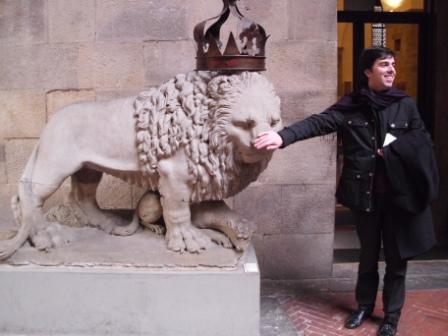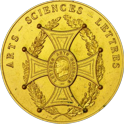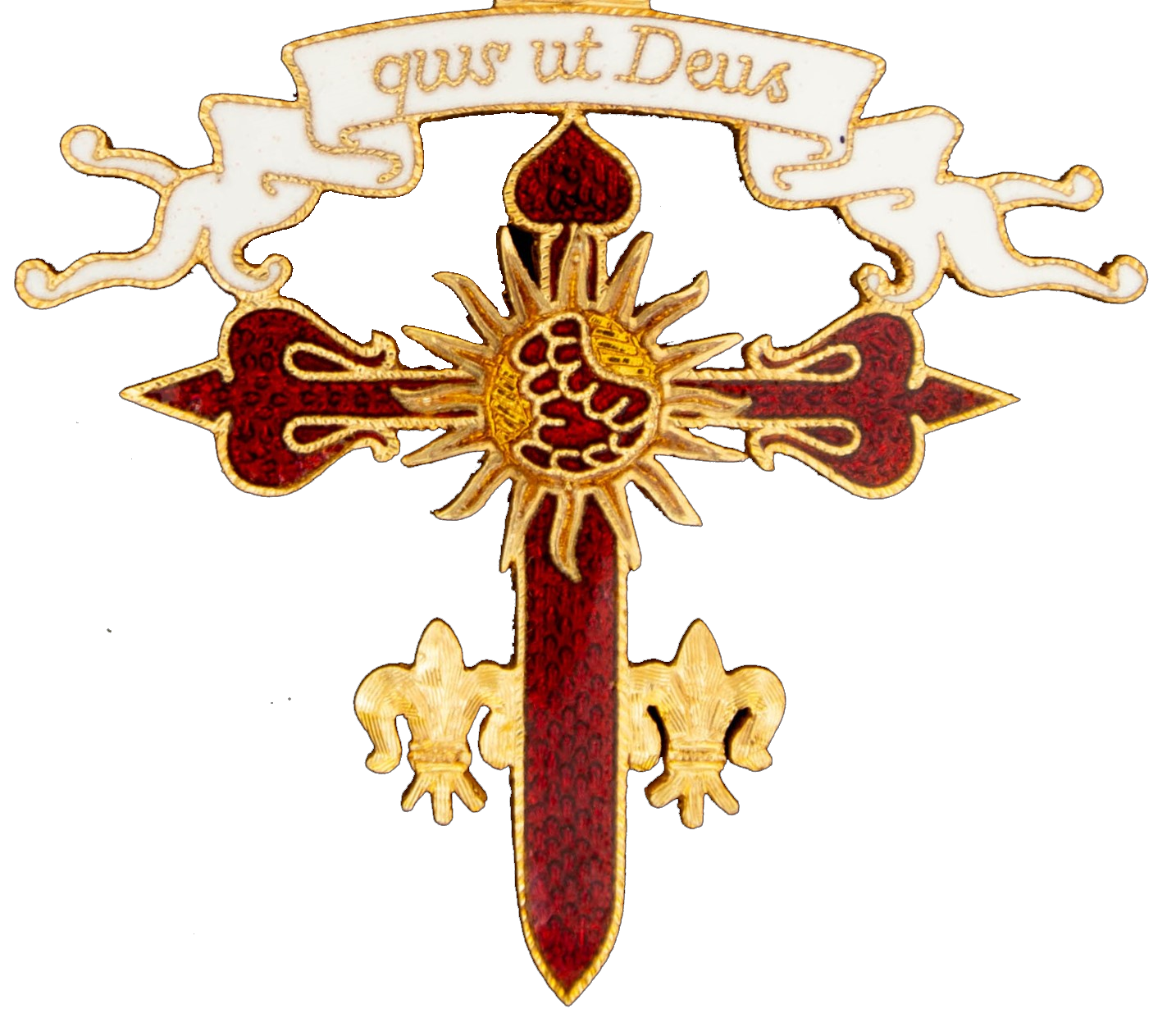
Madonna as never seen before 2
Why Madonna?
Besides being the Most Successful Female Artist of All Time, Madonna is able to embrace generations by camouflaging herself in the many personas she interprets; characters with which the world identifies itself. Madonna charismatically externalizes the focal points of human frailty, fighting in a way to break fake moral values, taboos and prejudices -- for example, in the fight against xenophobia, racism, world hunger, deforestation, human rights, an individual’s right to choose, and freedom of expression.
Many question why the youth identify with the way she expresses herself through art. Madonna is a leader par excellence; a pioneer in valuing freedom and success in all manners as much spiritually as socially. Her impulsiveness and self esteem, linked to her thirst for independence evoke in the young a reflection of their own desires and expectations not only of themselves, but also of the world that surrounds them. In a certain way, Madonna assumes the language of those who aspire to see a future free of the diseases that corrupt and destroy the essence of being human. The new generations also identify themselves with the maternal side of the singer: the “mother” who cares for, teaches, corrects and advices, who wants to love and be loved by all, who encourages the discovery of the secret to happiness through reflection by valuing efficiency and perfection. Her advice is to espouse the ambition to know a little of everything and to do everything the best way possible.
“Yes, I want people of all ages to be interested in my music. But only for one reason, no two… The first is that I have very pertinent messages that I want to pass on. If children hear them, it would be fantastic. The second reason is that the more I sell, the more money I make, and the more I can help others.”
“The distinction between the moral and artistic aspects is fundamental, but no less important is the connection between them. Each conditions the other in a profound way. In producing a work, artists express themselves to the point where their work becomes a unique disclosure of their own being, of what they are and how they are. And there are endless examples of this in human history. In shaping a masterpiece, the artist not only summons his work into being, but also in some way reveals his own personality by means of it. For him art offers both a new dimension and an exceptional mode of expression for his spiritual growth. Through his works, the artist speaks to others and communicates with them. The history of art, therefore, is not only a story of works produced but also a story of men and women. Works of art speak of their authors; they enable us to know their inner life, and they reveal the original contribution which artists offer to the history of culture.” – POPE JOHN II
The composition of the painting consists mainly of the following elements:
1. Madonna in the foreground;
2. Three white tigers;
3. Astronomical elements;
4. Undertones of Kabbalah.
1.1. Madonna, dressed in red, is reclining over two tigers, with three quarters of her face showing and gazing slightly to the right. Her mouth suggests movement and the makings of a smile. Her left arm is resting to the side and her right hand is caressing one of the tigers. Her left foot is in the foreground resting on the base and opposite on a slightly higher level.
1.2. The tiger in the foreground and to Madonna’s right is sleeping; the tiger to its immediate right is looking fixedly at the singer; and the third tiger, with its back to the Diva, has its head in profile, showing its right side.
1.1. Surrounding the subjects of the painting are astronomical elements such as the nebula, clouds of dust, hydrogen and plasma.
1.3. On the back of the third tiger there is a sketch of a tree. (see 2.1.4.).
2. Symbolism. Symbolism designates a representative element that is visible to stand for something invisible such as an object, a concept/idea, or a determined quantity or quality. The “symbol” is an essential element in communication found in daily life and in all aspects of human knowledge. Even though there are symbols that are universally understood, there are some that are understood only within a determined group or context (religious, cultural, etc.).
The specific representation of each symbol may result from a natural process or may be stipulated so that the receptor (a person or specific group of people) is able to interpret its meaning and give it the intended connotation. It can also be, more or less, physically related with the object or idea it represents whether it be graphic, three-dimensional, a sound or even a gesture.
An example of this is the convention of the white dove as the universal symbol of peace, the dove of peace and the religious representation as the Holy Spirit.
2.1.1. “Madonna dressed in red”. Red signifies strength, virility, femininity, and dynamism. It is an ardent color, even enervating. It imposes itself without discretion. It is an essentially hot color overflowing with life and excitement. It is also a color that represents Madonna’s faith in Kabbalah.
“Reclining on one of the tigers”. On the one hand Madonna subdues the irrational and on the other becomes entangled with the wildness of nature, affirming herself as a feline leader who continually plans her next ambush. She possesses an exotic, innate talent and a beautiful, gracious and charming appearance. Nevertheless she can be proud, authoritative, and dislike being contradicted. And, despite having a virtuous heart, has a hard time releasing her prey.
“Gazing slightly to the right”. A very charismatic and extroverted person with high artistic and creative potential, Madonna reveals her wishes and concerns with much intensity. However, she needs moments of solitude to reflect and study and has difficulty in showing affection. She may give the impression of being too serious or cold; both of which are not true. She is shy in showing her love for others. She is generous and easily moved.
“Her mouth suggests movement and the makings of a smile”. Madonna has the power of communication. Her voice captivates millions: one of her more energetic traits that attest to her artistic talent.
“Her left arm is resting to the side and her right hand is caressing one of the tigers”. The word arm is used as a synonym for the upper extremity or upper member of the human body, its last part being the hand which is important to human culture as the organ that “holds” power. The large capacity of movement of the hand allowed men to develop ways of communication such as hand signaling which could also be used as a form of defense. Images of the various arms in Hindu gods represent each god’s characteristics: the arms of each deity represent extensions of the god’s inner energy and the objects in its hands represent symbols of their many powers in the celestial order.
“Her left foot is on the foreground resting on the base and opposite on a slightly higher level”. The foot resting on the floor shows that Madonna is, on the one hand, a perfectionist and critical. She can take responsibility too far, and not being able to feel satisfied, constantly criticize herself and her reactions. She is exceptionally well organized and pays attention to the smallest of details. On the other hand, the foot found on a higher level signifies a search for inner knowledge, the constant change of will and style not just personal but professional. Her tireless search of superior inspiration has amazed her public throughout her career.
2.1.2. “The white tigers”. The white tigers are the largest and rarest of all the felines. Their size varies according to their subspecies: the Samatra tigers are the smallest and the Amur tigers the largest. Their fur is creamy white with long, brown stripes; it grows thicker in winter. Their eyes are blue and their nose is pink. These feline are a product of recessive genes where both parents carry the same gene responsible for the clear fur color. They are not albinos.
Tigers are more active at sunset and at night. They hunt by ambush and depend more on their vision and hearing than on their sense of smell. They are loners (except during the mating season) and territorial. Their fur color is not conducive to ambush hunting which relies on camouflage and puts these animals at great risk in the wild to the point of only being able to exist in specially built habitats and under human care.
In Chinese mythology the tiger is considered a yang, masculine and positive element. It is seen as the king of mountain and forest animals and has the power to hunt spirits and ghosts.
“The tiger in the foreground is sleeping”. Lulled by the magnetism and power of Madonna’s vibrant figure, the tiger does not feel frightened by her presence nor does it see her as a predator would. It does feel love for its protector. Madonna is its sentry. A butterfly (see 3.1.) rests on the tiger’s left paw as if having found a safe place to rest. It is the link between soul, inspiration, creation and conception.
“The tiger is looking at Madonna”. The sweetness of the Tiger’s look is almost human, “Whoever looks only at a star in the heavens will forever keep it – Because you will never be mine I have you forever“
“The third tiger is with its back to the Diva”. This tiger is the guardian of this unique artist, entrusted to humanity by its Creator.
The stripes on the tiger’s back suggest an outline of a tree – the Kabbalistic tree (see 2.1.4.). Madonna’s search for Kabbalistic teachings is intrinsic in this symbol.
In the painting the tigers also signify “The Three Graces”, which symbolize the Venus’ accomplices and Eros’ pursuers.
2.1.3. “The universe is codified. Isn’t it incredible that there are laws in the universe and that you can discover them and live your life according to them and, at the same time, you change the world for the better? Isn’t that incredible?”
Astronomy. Astronomy is a science that studies planets, stars, satellites, comets, solar systems, constellations, and nebulae. It is also discovers and names new astros. Astronomy studies the movement of celestial bodies, their composition and distances between them.
Nebulae. Nebulae are clouds made of dust, hydrogen and plasma. They are regions where stars are constantly formed such as the Eagle Nebula. This nebula is found in one of the most beautiful and famous images from NASA, “The Pillars of Creation”. The formation process of stars is extremely violent: remnants are thrust into space in a huge explosion which then form countless planets and planetary systems.
2.1.4. Undertones of Kabbalah. Kabbalah -- (קבלה QBLH) Hebrew for “that which is received” or “oral tradition” -- is not a religion or a cult; it is a body of mystical teachings based on the Torah, the Jewish scriptures. Kabbalah is the attempt to understand God through studying the scriptures, kabbalistic writings, and meditation. Also, by learning and acting in accordance to kabbalistic teachings, its followers believe they will improve their lives and achieve fulfilment for themselves and humanity as a whole. Through good deeds kabbalists can heal themselves and eventually the world.
Like most mystical traditions, Kabbalah has a strong symbology bent. The Sephirothic Tree, a tree composed of ten circles, signifies the thirty-two paths of wisdom. It is also believed to be a graphic representation of how the universe began. A red string bracelet, Hamsa, is worn for protection against the evil eye (preventing misfortune) and to bring good luck and positive energy. It is believed that if one winds a red string seven times around Rachel’s tomb in Israel, it will be endowed with mystical powers.
3. The link between the painting and the mythological symbolism as adopted from Art History.
Throughout time, the painters who marked the History of Art developed themes dominated by mythological symbolism and were influenced, according to Freud’s theories, by dreams of surreal images that reveal our capacity to interpret experiences with the unconscious.
Madonna as portrayed on the canvas is an allusion to Venus and Psyche. In this painting it is easy to see the merging of both these allegoric figures, especially of the latter.
Psyche: Greek word signifying soul. (It is common to find representations of Psyche with butterfly wings).
The myth of Psyche is narrated in the book The Golden Ass by Apuleius who describes her as a beautiful mortal for whom Eros, the god of love, falls in love. She is so beautiful that Venus, goddess of beauty and love and mother of Eros, becomes furious because men stop worshiping her and start worshiping Psyche, a mere mortal.
The goddess orders her son to strike Psyche with one of his arrows thereby forcing her to fall in love with the ugliest being alive. But, contrary to Venus’ desires, Eros ends up falling in love with the young woman after being accidentally pierced by one of his own arrows.
Since Eros falls in love with her, he no longer uses his arrows against her. Time passes on and Psyche still doesn’t fall for anyone; none of her admirers becomes her groom.
Therefore, Venus realizes that she must use more powerful measures. She makes up a story saying that she has lost some of her beauty by tending to Eros’ wound and asks Psyche to go to the Underworld (Hades or Elysian Fields)and ask Persephone for a little of hers. Venus is certain that Psyche will not survive the trip. Once again, the goddess is wrong. Psyche convinces Persephone to fill a small box with her beauty to give to Venus.
On her way to deliver the box to Venus, Psyche begins to think that her beauty has suffered from so many jobs and gives in to temptation. She opens the box only to find it empty except for the infernal sleep that overcomes her.
Eros, who is now cured of his wound, goes to his lover’s rescue. He puts the sleep back in the box, wakes Psyche, and makes her take the box to his mother.
While Psyche is delivering the box to Venus, Eros looks for Zeus and asks to be wed to Psyche. Zeus grants his request and later Psyche becomes immortal.
The union between love and soul – “Psyche” means soul
The butterfly is a symbol of the soul. Just as a butterfly abandons its cocoon to fly away, so is the spirit liberated of the Physical body to gain infinite space. The butterfly also represents rebirth and immortality. In Japan, the butterfly is associated with Woman given its metamorphosis from an egg to a caterpillar to a cocoon in which it transforms into a butterfly; these are similar stages our soul passes to attain enlightenment.
The butterfly symbolizes change. “The power of the butterfly is like the air. It is the ability to know one’s mind and to change it; it is the art of creation, of transformation”.
In the painting, the butterfly represents Madonna and the artist’s creative journey
First stage - when the idea is born but is not yet reality. The egg stage is the conception point of an idea;
Second stage- the larva emerges when we have to make a decision;
Third stage – the cocoon is the development of the project. Work to be done;
Final stage – the transformation: leave the cocoon and fly away. The end project.
The butterfly’s symbolic message is: create, transform, change and have the courage to accept.
God the Creator selects Madonna as the source of the painter’s inspiration. The painter becomes the procreator.
The symbols of the painting are simple. Nevertheless, the allusions to love’s common sense shine through in a composition rich in mystery offering the observer a mixture of tenderness, feeling and energy.
The glowing colors of the fur mix with the whiteness thereby emphasizing the chromatic stimulus of the fabric and the gentle scenery.
Here, Madonna is love, grace and delight; mystifying the marvellous glory of passion in paramount service of her ideal: eternal youth, beauty and spirituality.
4. Spiritual interpretation of the painting:
The body of the main character poses with grace and elegance. The charm she emanates is highly captivating without being common.
Throughout her life Madonna has enjoyed moving up socially. Her success and the multitude of people who succumb to her charms remain unstoppable. Her magnetism is not only obvious, but it is also refined. Her seemingly unperturbed style is the result of having achieved Iconic status as a singer and in other media.
She is represented in a timeless yet sensual manner, without carnal pretensions, in keeping with her artistic character in which she revolutionizes common dress codes.
This painting emphasizes Madonna’s more human, but less publicized, side. We are used to being spell bound by her eccentricities; however, here, she radiates beauty.
5. Category and Technical details :
This painting can be classified as Fantastic Art. Fantasy has been an integral part of art since its beginnings but was especially important for Mannerism, Romanticism, Symbolism, and Surrealism. Fantastic Art celebrates fantasy, imagination, the world of dreams, the grotesque, visions, etc. Within symbolism, the themes can be divided into mythology, the occult and mysticism. In French this genre is called "le fantastique"; in English it is sometimes referred to as Visionary Art, Grotesque Art or Mannerism.
In the largeness of the painting, the movement of the figures stands out as well as the combination of colors, the symbolic vision and the interaction between the figures and the observer -- these characteristics will be developed along the pictorial process.
To place the figures within the space of the canvas, I opted for a horizontal structure aided by a view from below.
The distribution of all the elements is balanced by the play of color and light so as to enhance the main figure.
The painting was developed with careful detail: the chromatics and minutia of the textures (fur, fabric, representation of the epidermis, etc.), the elements represented, and the colorful and luminous environment. All these highlight the main figure. This is the nucleus of only one story composed by an abundance of symbolism.
It is difficult to take in the painting as whole that is why one is easily attracted to Madonna’s physiognomy.
For the allocation of colors, I used Rubens and Veronese oils though the following tones were studied and particularly chosen for the work in question: the whites, golds, the red, pink and carmine tonalities, the violets and shaded tones.
The painting and its composition are absolutely original and not reproductions from photographs.
Size of painting - 260 cm x 180 cm;
Materials – Oil on linen canvas;
Time table - From November, 2008 to the end of April, 2009;
Schedule imposed to finish work - 8 to 16 hours daily;
Total labor invested: 2,700 hours
Proposal/Purpose of work (presentation):
a)Biennale Internazionale Dell’Arte Contemporanea, Florence, 2009
b) A percentage of the sale/auction of this painting will go to a registered 501 c3 non-profit organization.
c) Private collection.
“The painting that I present is an appeal to the art that intervenes in social life, freedom, imagination, fantasy, discovery and dreaming. I’m not interested in obeying any one rule or trend. My simple defense and consideration is that artistic creation ends up modifying, surpassing and improving them.” O.C.
2. The following Works of Art and respective Authors were studied (in chronologic order):
• Vase of green steatite carved for King Gudea of Lagash circa 2025 B.C.;
• Venus in her Sea Shell. Before 79 B.C. – House of Venus, Pompeii;
• “Africa” - Early 4th century C.E. Floor mosaic in the Roman Vilha at Piazza Armerina, Sicily (86);
• “Adam and Eve” – Early Christian art – 4th century A.D.;
• “The Fall of Man” – Hugo van der Goes – 1470;
• “Portrait of Cecilia Gallerani” or “Lady with an Ermine” – Leonardo da Vinci – 1485;
• “Venus of Urbino” – Titian - 1538;
• Mercury and Psyche – Bronze by Adriaen de Vries – 1593;
• “Death of Cleopatra” – Jean – Baptiste Regnault – 1796/97;
• “Madame Récamier” – Jacques – Louis David – 1800;
• “Cupid and Psyche” – Jacques – Louis David – 1817;
• “Mars Disarmed by Venus and the Three Graces” – Jacques – Louis David – 1822 /24;
• “Olympia” – Eduard Monet – 1832/83;
• “The Loss of Virginity” or “Spring of Awakening” – Paul Gauguin – 1890/91;
• “The abduction of Psyche” – William Adolphe Bouguereau - 1895;
• “The Sphinx” or “The Caresses” – Fernand Khnopff – 1896;
• “Sleeping Venus” – Paul Delvaux – 1897;
• “The Sleeping Gypsy” – Henri Rousseau – 1897;
• “The Birth of the Tear” – Edgar Ende – 1947.
Bibliography and Sources of Inspiration:
• Encyclical Letter “Pacem In Terris”: Pope John XXIII - 1963;
• Letter to Artists: pope John Paul II - 1999;
• “Book of Hindu Imagery”: The Gods & Their Symbols by Jansen, Eva – 1993;
• “David” – Luc de Nanteuil;
• Dateline Program;
• “Earthborn Wisdom” Understanding Symbology Of The Everyday World by Wells, Susan;
• Interviewing Minsane – Madonna’s Astrologist;
• “Great Paintings of the Western World” – Gallup Gruitrooy and Weisberg;
• www.madonna.com
• Madonna/”Ray of Light” – Maverick/Warner Bros.;
• Madonna/ “I’m Going to Tell You a Secret” - Warner Bros.;
• Madonna/”The Confessions Tour” – Eric Broms/Jamie King;
• NASA;
• “World Art Treasures” – Geoffrey Hindley/Norman Reid;
• “Painting from A to Z /A History of Painting from Prehistoric Times to the Present day”;
• “Paths of Wisdom” - A Guide to the Magical Cabala by John Michael Greer;
• Texts developed by the Lisbon Zoo;
• “The Fountain” – Darren Aronofsky - 2006;
• “Wikipedia, the free encyclopedia”
1.2. The tiger in the foreground and to Madonna’s right is sleeping; the tiger to its immediate right is looking fixedly at the singer; and the third tiger, with its back to the Diva, has its head in profile, showing its right side.
1.1. Surrounding the subjects of the painting are astronomical elements such as the nebula, clouds of dust, hydrogen and plasma.
1.3. On the back of the third tiger there is a sketch of a tree. (see 2.1.4.).
2. Symbolism. Symbolism designates a representative element that is visible to stand for something invisible such as an object, a concept/idea, or a determined quantity or quality. The “symbol” is an essential element in communication found in daily life and in all aspects of human knowledge. Even though there are symbols that are universally understood, there are some that are understood only within a determined group or context (religious, cultural, etc.).
The specific representation of each symbol may result from a natural process or may be stipulated so that the receptor (a person or specific group of people) is able to interpret its meaning and give it the intended connotation. It can also be, more or less, physically related with the object or idea it represents whether it be graphic, three-dimensional, a sound or even a gesture.
An example of this is the convention of the white dove as the universal symbol of peace, the dove of peace and the religious representation as the Holy Spirit.
2.1.1. “Madonna dressed in red”. Red signifies strength, virility, femininity, and dynamism. It is an ardent color, even enervating. It imposes itself without discretion. It is an essentially hot color overflowing with life and excitement. It is also a color that represents Madonna’s faith in Kabbalah.
“Reclining on one of the tigers”. On the one hand Madonna subdues the irrational and on the other becomes entangled with the wildness of nature, affirming herself as a feline leader who continually plans her next ambush. She possesses an exotic, innate talent and a beautiful, gracious and charming appearance. Nevertheless she can be proud, authoritative, and dislike being contradicted. And, despite having a virtuous heart, has a hard time releasing her prey.
“Gazing slightly to the right”. A very charismatic and extroverted person with high artistic and creative potential, Madonna reveals her wishes and concerns with much intensity. However, she needs moments of solitude to reflect and study and has difficulty in showing affection. She may give the impression of being too serious or cold; both of which are not true. She is shy in showing her love for others. She is generous and easily moved.
“Her mouth suggests movement and the makings of a smile”. Madonna has the power of communication. Her voice captivates millions: one of her more energetic traits that attest to her artistic talent.
“Her left arm is resting to the side and her right hand is caressing one of the tigers”. The word arm is used as a synonym for the upper extremity or upper member of the human body, its last part being the hand which is important to human culture as the organ that “holds” power. The large capacity of movement of the hand allowed men to develop ways of communication such as hand signaling which could also be used as a form of defense. Images of the various arms in Hindu gods represent each god’s characteristics: the arms of each deity represent extensions of the god’s inner energy and the objects in its hands represent symbols of their many powers in the celestial order.
“Her left foot is on the foreground resting on the base and opposite on a slightly higher level”. The foot resting on the floor shows that Madonna is, on the one hand, a perfectionist and critical. She can take responsibility too far, and not being able to feel satisfied, constantly criticize herself and her reactions. She is exceptionally well organized and pays attention to the smallest of details. On the other hand, the foot found on a higher level signifies a search for inner knowledge, the constant change of will and style not just personal but professional. Her tireless search of superior inspiration has amazed her public throughout her career.
2.1.2. “The white tigers”. The white tigers are the largest and rarest of all the felines. Their size varies according to their subspecies: the Samatra tigers are the smallest and the Amur tigers the largest. Their fur is creamy white with long, brown stripes; it grows thicker in winter. Their eyes are blue and their nose is pink. These feline are a product of recessive genes where both parents carry the same gene responsible for the clear fur color. They are not albinos.
Tigers are more active at sunset and at night. They hunt by ambush and depend more on their vision and hearing than on their sense of smell. They are loners (except during the mating season) and territorial. Their fur color is not conducive to ambush hunting which relies on camouflage and puts these animals at great risk in the wild to the point of only being able to exist in specially built habitats and under human care.
In Chinese mythology the tiger is considered a yang, masculine and positive element. It is seen as the king of mountain and forest animals and has the power to hunt spirits and ghosts.
“The tiger in the foreground is sleeping”. Lulled by the magnetism and power of Madonna’s vibrant figure, the tiger does not feel frightened by her presence nor does it see her as a predator would. It does feel love for its protector. Madonna is its sentry. A butterfly (see 3.1.) rests on the tiger’s left paw as if having found a safe place to rest. It is the link between soul, inspiration, creation and conception.
“The tiger is looking at Madonna”. The sweetness of the Tiger’s look is almost human, “Whoever looks only at a star in the heavens will forever keep it – Because you will never be mine I have you forever“
“The third tiger is with its back to the Diva”. This tiger is the guardian of this unique artist, entrusted to humanity by its Creator.
The stripes on the tiger’s back suggest an outline of a tree – the Kabbalistic tree (see 2.1.4.). Madonna’s search for Kabbalistic teachings is intrinsic in this symbol.
In the painting the tigers also signify “The Three Graces”, which symbolize the Venus’ accomplices and Eros’ pursuers.
2.1.3. “The universe is codified. Isn’t it incredible that there are laws in the universe and that you can discover them and live your life according to them and, at the same time, you change the world for the better? Isn’t that incredible?”
Astronomy. Astronomy is a science that studies planets, stars, satellites, comets, solar systems, constellations, and nebulae. It is also discovers and names new astros. Astronomy studies the movement of celestial bodies, their composition and distances between them.
Nebulae. Nebulae are clouds made of dust, hydrogen and plasma. They are regions where stars are constantly formed such as the Eagle Nebula. This nebula is found in one of the most beautiful and famous images from NASA, “The Pillars of Creation”. The formation process of stars is extremely violent: remnants are thrust into space in a huge explosion which then form countless planets and planetary systems.
2.1.4. Undertones of Kabbalah. Kabbalah -- (קבלה QBLH) Hebrew for “that which is received” or “oral tradition” -- is not a religion or a cult; it is a body of mystical teachings based on the Torah, the Jewish scriptures. Kabbalah is the attempt to understand God through studying the scriptures, kabbalistic writings, and meditation. Also, by learning and acting in accordance to kabbalistic teachings, its followers believe they will improve their lives and achieve fulfilment for themselves and humanity as a whole. Through good deeds kabbalists can heal themselves and eventually the world.
Like most mystical traditions, Kabbalah has a strong symbology bent. The Sephirothic Tree, a tree composed of ten circles, signifies the thirty-two paths of wisdom. It is also believed to be a graphic representation of how the universe began. A red string bracelet, Hamsa, is worn for protection against the evil eye (preventing misfortune) and to bring good luck and positive energy. It is believed that if one winds a red string seven times around Rachel’s tomb in Israel, it will be endowed with mystical powers.
3. The link between the painting and the mythological symbolism as adopted from Art History.
Throughout time, the painters who marked the History of Art developed themes dominated by mythological symbolism and were influenced, according to Freud’s theories, by dreams of surreal images that reveal our capacity to interpret experiences with the unconscious.
Madonna as portrayed on the canvas is an allusion to Venus and Psyche. In this painting it is easy to see the merging of both these allegoric figures, especially of the latter.
Psyche: Greek word signifying soul. (It is common to find representations of Psyche with butterfly wings).
The myth of Psyche is narrated in the book The Golden Ass by Apuleius who describes her as a beautiful mortal for whom Eros, the god of love, falls in love. She is so beautiful that Venus, goddess of beauty and love and mother of Eros, becomes furious because men stop worshiping her and start worshiping Psyche, a mere mortal.
The goddess orders her son to strike Psyche with one of his arrows thereby forcing her to fall in love with the ugliest being alive. But, contrary to Venus’ desires, Eros ends up falling in love with the young woman after being accidentally pierced by one of his own arrows.
Since Eros falls in love with her, he no longer uses his arrows against her. Time passes on and Psyche still doesn’t fall for anyone; none of her admirers becomes her groom.
Therefore, Venus realizes that she must use more powerful measures. She makes up a story saying that she has lost some of her beauty by tending to Eros’ wound and asks Psyche to go to the Underworld (Hades or Elysian Fields)and ask Persephone for a little of hers. Venus is certain that Psyche will not survive the trip. Once again, the goddess is wrong. Psyche convinces Persephone to fill a small box with her beauty to give to Venus.
On her way to deliver the box to Venus, Psyche begins to think that her beauty has suffered from so many jobs and gives in to temptation. She opens the box only to find it empty except for the infernal sleep that overcomes her.
Eros, who is now cured of his wound, goes to his lover’s rescue. He puts the sleep back in the box, wakes Psyche, and makes her take the box to his mother.
While Psyche is delivering the box to Venus, Eros looks for Zeus and asks to be wed to Psyche. Zeus grants his request and later Psyche becomes immortal.
The union between love and soul – “Psyche” means soul
The butterfly is a symbol of the soul. Just as a butterfly abandons its cocoon to fly away, so is the spirit liberated of the Physical body to gain infinite space. The butterfly also represents rebirth and immortality. In Japan, the butterfly is associated with Woman given its metamorphosis from an egg to a caterpillar to a cocoon in which it transforms into a butterfly; these are similar stages our soul passes to attain enlightenment.
The butterfly symbolizes change. “The power of the butterfly is like the air. It is the ability to know one’s mind and to change it; it is the art of creation, of transformation”.
In the painting, the butterfly represents Madonna and the artist’s creative journey
First stage - when the idea is born but is not yet reality. The egg stage is the conception point of an idea;
Second stage- the larva emerges when we have to make a decision;
Third stage – the cocoon is the development of the project. Work to be done;
Final stage – the transformation: leave the cocoon and fly away. The end project.
The butterfly’s symbolic message is: create, transform, change and have the courage to accept.
God the Creator selects Madonna as the source of the painter’s inspiration. The painter becomes the procreator.
The symbols of the painting are simple. Nevertheless, the allusions to love’s common sense shine through in a composition rich in mystery offering the observer a mixture of tenderness, feeling and energy.
The glowing colors of the fur mix with the whiteness thereby emphasizing the chromatic stimulus of the fabric and the gentle scenery.
Here, Madonna is love, grace and delight; mystifying the marvellous glory of passion in paramount service of her ideal: eternal youth, beauty and spirituality.
4. Spiritual interpretation of the painting:
The body of the main character poses with grace and elegance. The charm she emanates is highly captivating without being common.
Throughout her life Madonna has enjoyed moving up socially. Her success and the multitude of people who succumb to her charms remain unstoppable. Her magnetism is not only obvious, but it is also refined. Her seemingly unperturbed style is the result of having achieved Iconic status as a singer and in other media.
She is represented in a timeless yet sensual manner, without carnal pretensions, in keeping with her artistic character in which she revolutionizes common dress codes.
This painting emphasizes Madonna’s more human, but less publicized, side. We are used to being spell bound by her eccentricities; however, here, she radiates beauty.
5. Category and Technical details :
This painting can be classified as Fantastic Art. Fantasy has been an integral part of art since its beginnings but was especially important for Mannerism, Romanticism, Symbolism, and Surrealism. Fantastic Art celebrates fantasy, imagination, the world of dreams, the grotesque, visions, etc. Within symbolism, the themes can be divided into mythology, the occult and mysticism. In French this genre is called "le fantastique"; in English it is sometimes referred to as Visionary Art, Grotesque Art or Mannerism.
In the largeness of the painting, the movement of the figures stands out as well as the combination of colors, the symbolic vision and the interaction between the figures and the observer -- these characteristics will be developed along the pictorial process.
To place the figures within the space of the canvas, I opted for a horizontal structure aided by a view from below.
The distribution of all the elements is balanced by the play of color and light so as to enhance the main figure.
The painting was developed with careful detail: the chromatics and minutia of the textures (fur, fabric, representation of the epidermis, etc.), the elements represented, and the colorful and luminous environment. All these highlight the main figure. This is the nucleus of only one story composed by an abundance of symbolism.
It is difficult to take in the painting as whole that is why one is easily attracted to Madonna’s physiognomy.
For the allocation of colors, I used Rubens and Veronese oils though the following tones were studied and particularly chosen for the work in question: the whites, golds, the red, pink and carmine tonalities, the violets and shaded tones.
The painting and its composition are absolutely original and not reproductions from photographs.
Size of painting - 260 cm x 180 cm;
Materials – Oil on linen canvas;
Time table - From November, 2008 to the end of April, 2009;
Schedule imposed to finish work - 8 to 16 hours daily;
Total labor invested: 2,700 hours
Proposal/Purpose of work (presentation):
a)Biennale Internazionale Dell’Arte Contemporanea, Florence, 2009
b) A percentage of the sale/auction of this painting will go to a registered 501 c3 non-profit organization.
c) Private collection.
“The painting that I present is an appeal to the art that intervenes in social life, freedom, imagination, fantasy, discovery and dreaming. I’m not interested in obeying any one rule or trend. My simple defense and consideration is that artistic creation ends up modifying, surpassing and improving them.” O.C.
2. The following Works of Art and respective Authors were studied (in chronologic order):
• Vase of green steatite carved for King Gudea of Lagash circa 2025 B.C.;
• Venus in her Sea Shell. Before 79 B.C. – House of Venus, Pompeii;
• “Africa” - Early 4th century C.E. Floor mosaic in the Roman Vilha at Piazza Armerina, Sicily (86);
• “Adam and Eve” – Early Christian art – 4th century A.D.;
• “The Fall of Man” – Hugo van der Goes – 1470;
• “Portrait of Cecilia Gallerani” or “Lady with an Ermine” – Leonardo da Vinci – 1485;
• “Venus of Urbino” – Titian - 1538;
• Mercury and Psyche – Bronze by Adriaen de Vries – 1593;
• “Death of Cleopatra” – Jean – Baptiste Regnault – 1796/97;
• “Madame Récamier” – Jacques – Louis David – 1800;
• “Cupid and Psyche” – Jacques – Louis David – 1817;
• “Mars Disarmed by Venus and the Three Graces” – Jacques – Louis David – 1822 /24;
• “Olympia” – Eduard Monet – 1832/83;
• “The Loss of Virginity” or “Spring of Awakening” – Paul Gauguin – 1890/91;
• “The abduction of Psyche” – William Adolphe Bouguereau - 1895;
• “The Sphinx” or “The Caresses” – Fernand Khnopff – 1896;
• “Sleeping Venus” – Paul Delvaux – 1897;
• “The Sleeping Gypsy” – Henri Rousseau – 1897;
• “The Birth of the Tear” – Edgar Ende – 1947.
Bibliography and Sources of Inspiration:
• Encyclical Letter “Pacem In Terris”: Pope John XXIII - 1963;
• Letter to Artists: pope John Paul II - 1999;
• “Book of Hindu Imagery”: The Gods & Their Symbols by Jansen, Eva – 1993;
• “David” – Luc de Nanteuil;
• Dateline Program;
• “Earthborn Wisdom” Understanding Symbology Of The Everyday World by Wells, Susan;
• Interviewing Minsane – Madonna’s Astrologist;
• “Great Paintings of the Western World” – Gallup Gruitrooy and Weisberg;
• www.madonna.com
• Madonna/”Ray of Light” – Maverick/Warner Bros.;
• Madonna/ “I’m Going to Tell You a Secret” - Warner Bros.;
• Madonna/”The Confessions Tour” – Eric Broms/Jamie King;
• NASA;
• “World Art Treasures” – Geoffrey Hindley/Norman Reid;
• “Painting from A to Z /A History of Painting from Prehistoric Times to the Present day”;
• “Paths of Wisdom” - A Guide to the Magical Cabala by John Michael Greer;
• Texts developed by the Lisbon Zoo;
• “The Fountain” – Darren Aronofsky - 2006;
• “Wikipedia, the free encyclopedia”
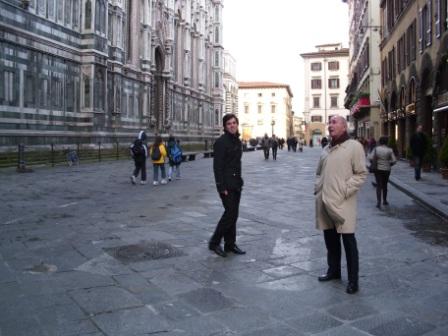
Sampayo Castro and Oscar Casares near the Duomo Cathedral
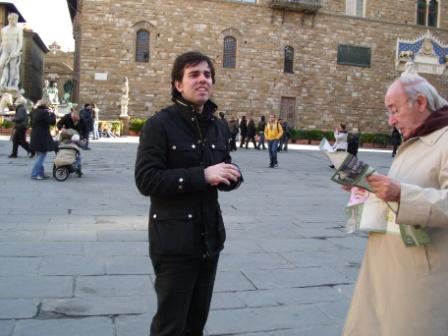

Oscar leaving the hotel

Oscar Casares arriving at the Florence Biennale
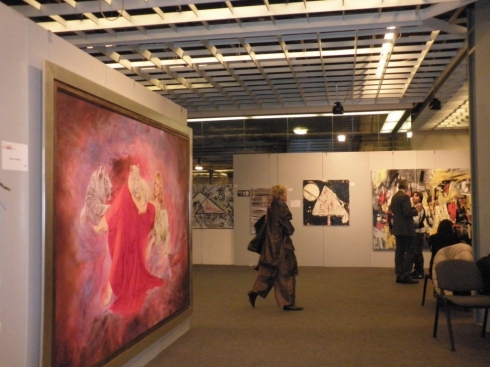
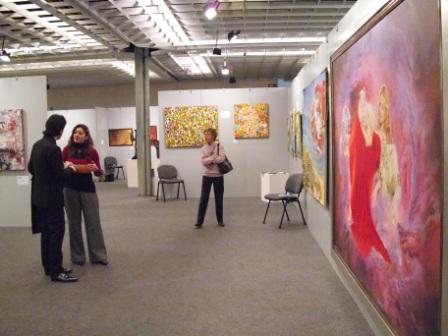
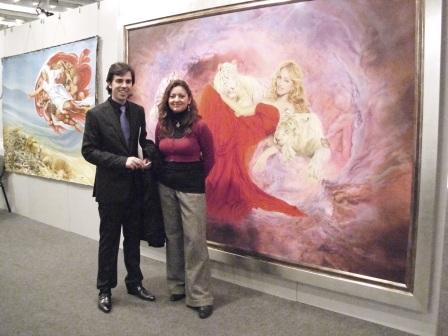
Maria-Helena (Icon.Madonna) and Oscar Casares next to Madonna’s painting/tribute
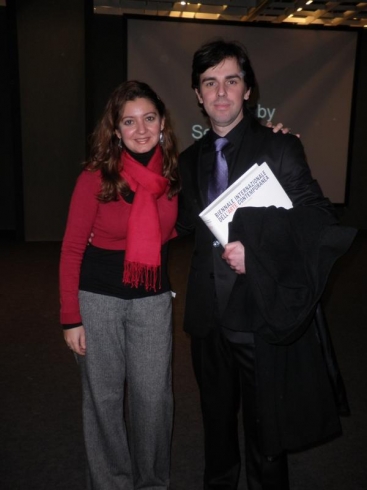
Maria-Helena (Icon.Madonna) and Oscar Casares
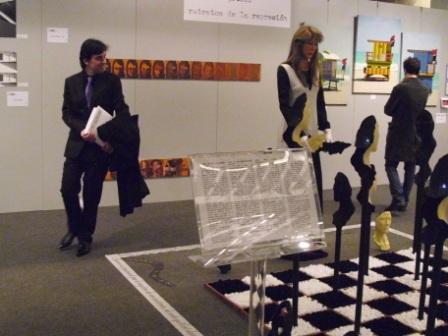
Casares admires some artworks exhibited at the Biennale
